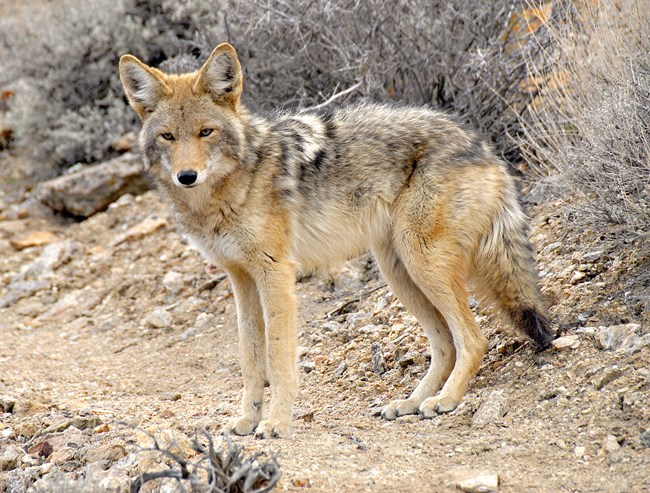Canis latransConservation status: least concern 
NPS / Neil Nurmi Basic Biology
DescriptionCoyotes in Death Valley are well adapted to survive in this harsh desert habitat. They tend to be smaller and more solitary than their eastern counterparts. They have a light gray to reddish-brown coat that blends in well with the bare rocks and sandy soils of the valley. Being diurnal, coyotes are active during both day and night, with peaks in activity at sunrise and sunset. Most foraging activity will occur after dark, but daytime activity increases during the mating season. Coyotes communicate by vocalizing, scent marking, various body displays, and are often heard yipping and barking after dark. With around a dozen different vocalization types, it is not uncommon to mistake a few coyotes communicating with each other for a larger group. They are highly intelligent and social animals and exhibit a high level of parental care. Courtship begins a few months before breeding, with the breeding season beginning in late winter and peaking in mid-spring. Both females and males are capable of breeding as yearlings, but the majority of individuals will not breed until their second year. Juvenile coyotes usually disperse alone, but sometimes in groups, at six to nine months of age. However, some coyotes do not disperse until their second year. Juveniles may disperse up to 100 miles from their den, but shorter dispersal distances from 5 to 30 miles are much more common. 
NPS photo Tracks & SignsCoyote tracks are similar to be those of a domestic dog, but with close inspection you can begin to tell the two apart. A coyote’s track will usually be laid out in a straight line, very direct. A dog's path will often wander as they explore an area. Coyote footprints are more oblong than those of a dog and often show small, sharp nails. A dog’s footprints will usually be rounded and show larger, rounded nails. 
NPS / Kurt Moses Threats & IssuesUnfortunately, human-coyote interactions have become soured in recent years. As perhaps well-meaning visitors feed them, this all too often results in an early death for the animal. In fact, many fed coyotes have learned to stop traffic by standing in roadways to beg for handouts. This is a dangerous behavior for the coyote, as well as humans near it, and leads to increased vehicle collisions, higher risk of attacks on visitors, and animals becoming dependent on human assistance to survive. Please remember: feeding any wildlife in the park is illegal! |
Last updated: September 30, 2021
